If you’ve read my “Duck Day” posts before, you know it’s my rundown of what corwin and I made for Thanksgiving. In 2023 we left for Aruba with my Mom that Saturday, and I thought I would work on the recap post then. But “Aruba” and “work” do not mix, and instead I read two lovely books and lounged about in the shade (and finally began to feel a little bit recovered from having had COVID in September…)
Anyway, now it’s February 2024 and I’m finally posting this so I can close the dozens of tabs still open on my browser since November!
In Duck Days past, corwin and I have cooked up some high concept menu themes (like the time we traced a map of the Silk Road, or the parody menu “American Classics,” or the year we did “togetherness“…), while other times we’ve stuck to a single cuisine as a theme (i.e. French). This year we decided to go for full-on Cantonese which means including a couple of nods to the Philippines and Singapore, where there are large Cantonese populations and the cuisine has been adapted with local flair. (Same could be said for the USA….)
Having grown up as a mixed-race Chinese-filipino kid in the 1970s, I spent a lot of my childhood eating in Chinese restaurants throughout suburban New Jersey, with very regular trips to NYC Chinatown. We ate a lot of takeout from “American” Chinese joints, and often had Christmas Day dinner at one of the slightly fancier Chinese restaurants (because my mom’s birthday is on Christmas and she would rather not cook on her birthday). If we went shopping in Manhattan in the morning, we went to dim sum after. If we went to a Broadway show at night, or even to Yankee Stadium which is way up in the Bronx, we still drove all the way down to Chinatown for a late-night dinner.
I understood as a kid that there was something “cultural” about going to Chinatown that I was supposed to “get,” but I didn’t really know what it was, and my family didn’t explicitly talk about it. But it meant I felt some kind of connection even if there really wasn’t a functional difference between me and non-Chinese tourist kids from the suburbs.
If I absorbed some cultural values on these trips they probably boiled down to these:
– It’s a virtue to eat.
– It’s a virtue to eat everything.
– It’s a virtue to eat everything your ancestors (probably) ate.
For a while my grandfather came to live with us, and I found it extremely frustrating that we had no common language, because I really wanted to grill him all day long about what his life was like growing up when there was still a dynasty going on. Like, whoa.
He liked going to Chinatown even though he spoke a different dialect from most of the merchants there. Because he could write things down, though, he could request special things from the waiters and go into the Chinese pharmacy and get various remedies. One thing, though, that he had going on was high blood pressure, and so his doctor (and my dad, who was an MD) had told him to cut salt out of his diet. So my mom was cooking everything low salt. (My grandfather must’ve just thought she was a terrible cook.) But his blood pressure didn’t go down. They couldn’t figure it out.
Until my dad found the tub of pork floss he had hidden in his room. For those not familiar with pork floss, try to imagine if chewing tobacco were made from beef jerky so finely shredded it had the texture of dryer lint. (It’s DELICIOUS.)
Anyway. Probably 90% of my identification with my Chinese heritage comes through food (the other 10% comes through kung fun movies, and I’m not even kidding).
tl;dr — Deciding to do a heavy-duty Cantonese meal is kind of a big deal for me.
But of course this is us, so we couldn’t ONLY do straight-up traditional, we had to find ways to bistronomize and fuse and elevate and have fun with the dishes.
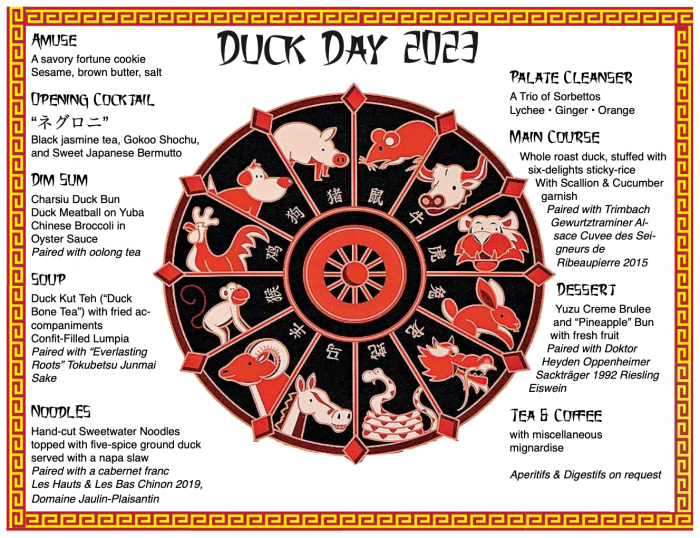
The Menu:
1) Amuse & Opening Cocktail:
A Savory Fortune Cookie
Name of the cocktail: ネグロに (Ne Gu Ro Ni, yes we’re writing it in Japanese)
2) Dim Sum:
Chashu Duck Baked Bun
Duck Meatball w/ Yuba
Chinese Broccoli in Oyster Sauce
with Oolong tea
3) Soup:
Duck Kut Teh with You Tiao (Chinese “crullers”)
served with a Crispy duck-confit filled Lumpia
4) Noodles:
Hand-cut Sweetwater noodle w/ ground duck topping
5) Palate Cleanser:
Trio of sorbettos: ginger, lychee, orange
6) Main Course:
Sticky-rice stuffed roast duck
With Scallion & Cucumber garnish
7) Dessert:
Yuzu Creme Brulee
Pineapple Bun
Orange Slice
8) Tea & Coffee
** Candied things
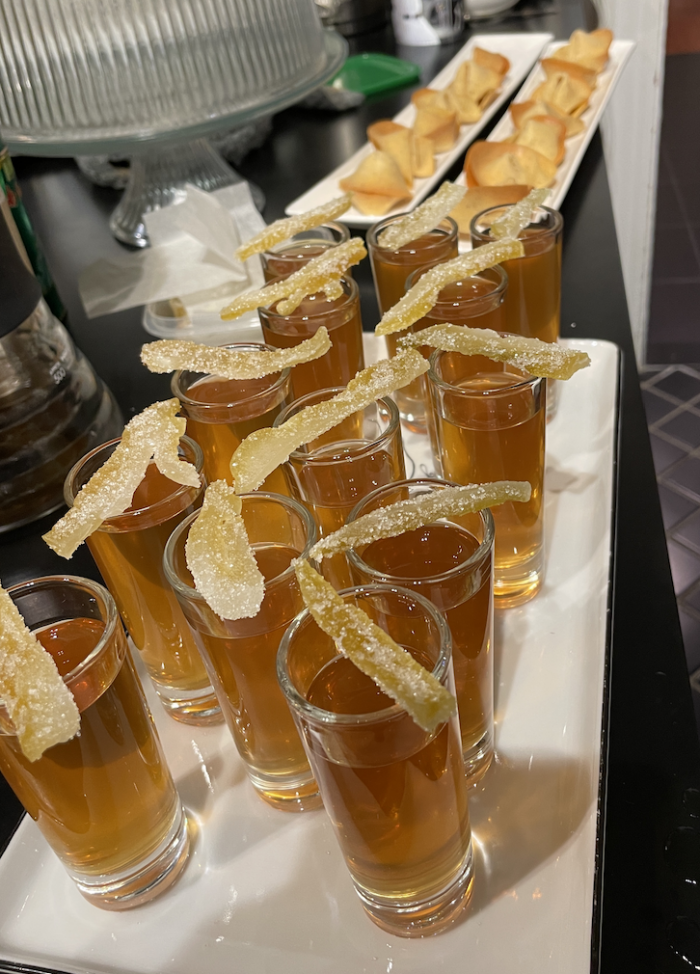
Opening Cocktail: Ne Gu Ro Ni (you can spell this with katakana)
Inspired by a friend’s recent musing on what counts as a negroni (e.g. by some definitions, concrete is a negroni…), corwin invented this one using the idea that a negroni is one part base spirit, one part bitter, and one part sweet. It uses Gokoo Shochu, which is very whiskey-like, as the base spirt, a Japanese “Bermutto” as the sweet component, and a black jasmine tea as the bitter.
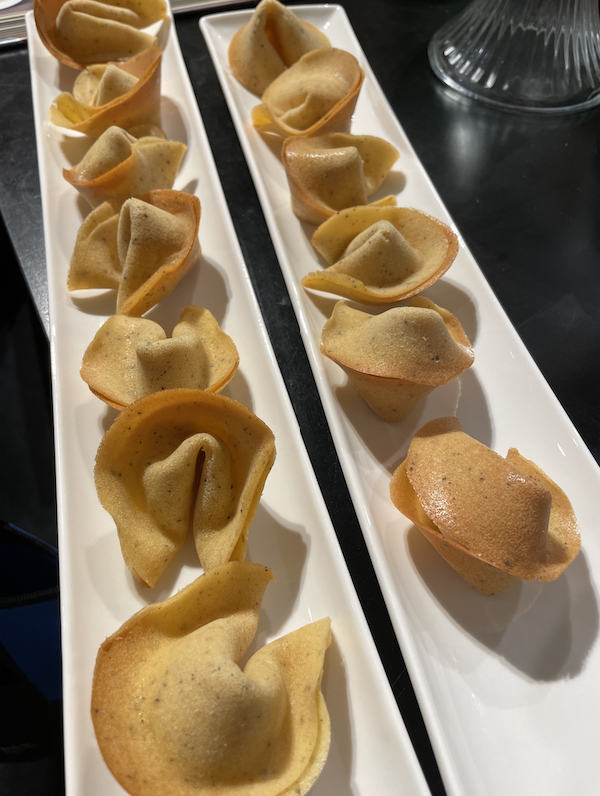
The Savory Fortune Cookie:
I like my amuses to be, well, amusing, and this seemed a good way to inject some whimsy. When I ran the test recipe for this, I made test fortunes that said things like “This is a test of the fortune cookie broadcast system.” “This is only a test.” “If this had been an actual fortune cookie, you would have received some Orientalist B.S.” and so on.
I based my recipe on this one for “Brown Butter Fortune Cookies” from Cook It Delicious: https://cooktildelicious.com/brown-butter-fortune-cookies/
The consensus among my foodie Twitter/Bluesky/etc cohort is that because the fortune cookie batter is mostly sugar and egg whites, trying to reduce the sugar wouldn’t work. But plenty of Cantonese cooking is savory while also being sweet, so I kept the sugar content the same and just pumped up the savory aspect. One test batch I added sesame oil to the brown butter and they were okay. Next batch I added the sesame oil FROM THE JAR OF LAO GAN MA and that kicked it right into the savory stratosphere! Delicious! (it also made the cookies slightly pink) The other thing I added was a sprinkling of sesame seeds and flake salt onto the unbaked cookies right before putting them in the oven.
They came out fantastic. The biggest problem I’ve usually found with homemade fortune cookies is that they come out soggy (or chewy) rather than crispy. What I found during the tests was that I could just keep putting the shaped cookies — held in shape by putting them into an egg carton the moment they’re shaped — into the oven on a low-ish heat (300 degrees, I think) for another few minutes beyond the expected bake time.
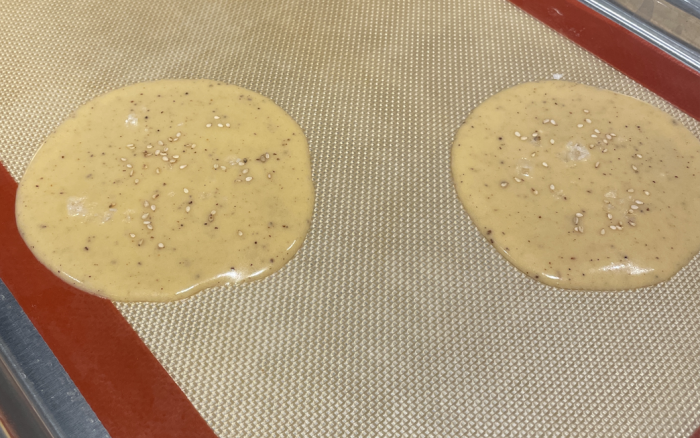
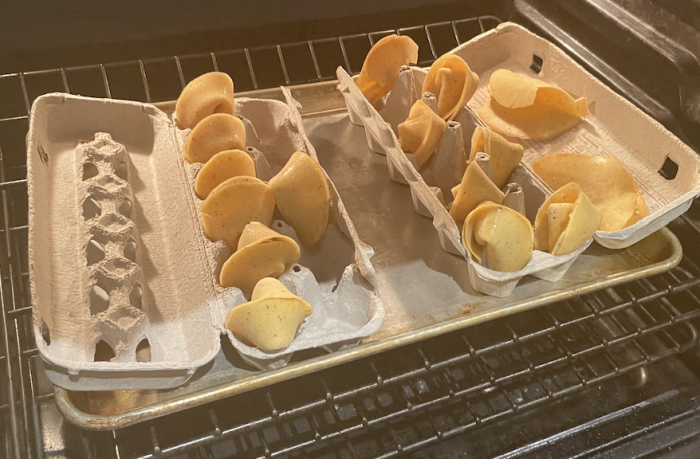
THE DIM SUM COURSE:
We don’t go into restaurants indoors when the COVID numbers are over a certain threshold, which means we haven’t been to a dim sum palace since before Omicron. And damn, I miss it.
Chashu Duck Baked Bun
Duck Meatball w/ Yuba
Chinese Broccoli in Oyster Sauce
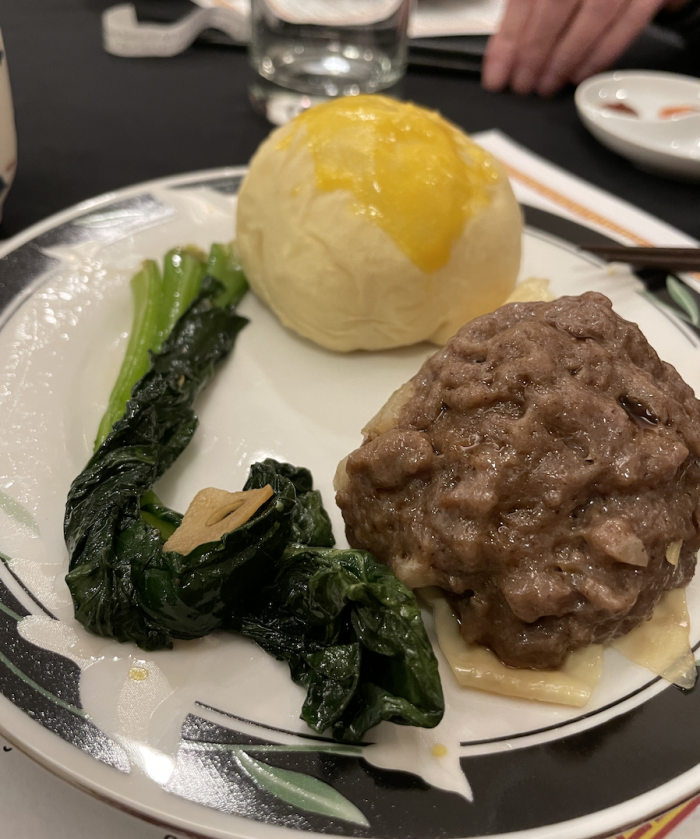
The chinese broccoli in oyster sauce is basically an excuse to get some green vegetables into our guests. According to Buddhist tradition, oyster sauce is vegetarian. No, really. (Chinese Cooking Demystified did a whole video on this: https://www.youtube.com/watch?v=mDC6Q5upKPE)
DUCK MEATBALL on Yuba
This is a duck version of the beef ball you usually get on tofu skin. corwin learned the technique that makes those balls so soft yet bouncy (it has to do with lye water), and guess what? It works for duck, too. (Another nod to Chinese Cooking Demystified, who posted their recipe here: https://www.reddit.com/r/Cooking/comments/bh7pjc/recipe_dim_sum_beef_balls_%E9%99%88%E7%9A%AE%E7%89%9B%E8%82%89%E7%90%83/ and the video here: https://www.youtube.com/watch?v=NsEPOKveJFQ)
Chashu Duck Baked Bun
This is basically the classic charsiu siopao but with duck instead of pork. We’ve made these before, but it’s a classic and good to return to to scratch that dimsum itch!
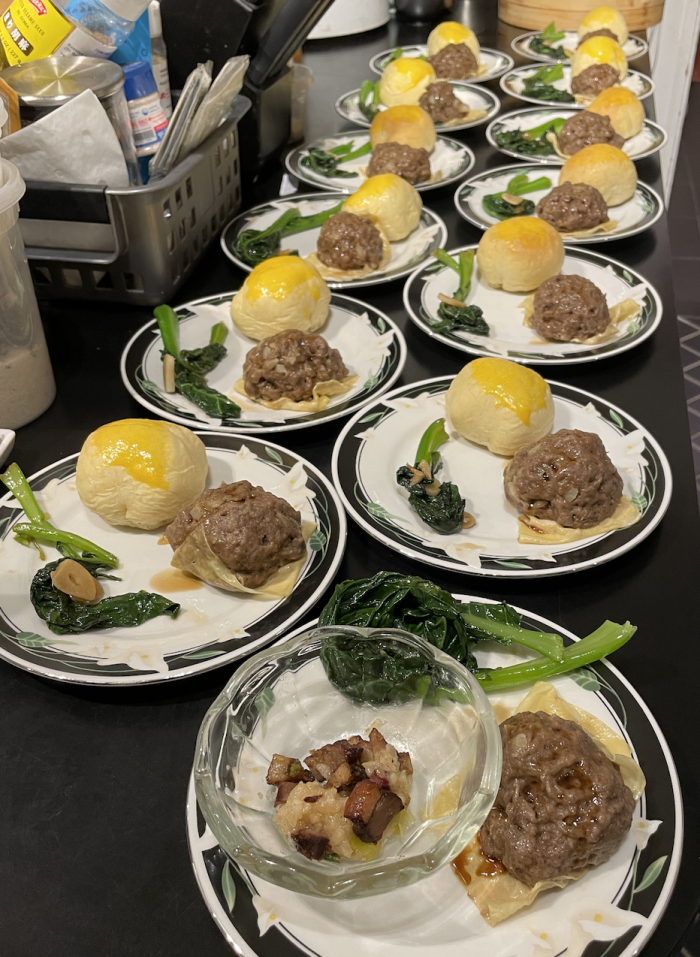
Duck Kut Teh with You Tiao (Chinese “crullers”)
served with a Crispy duck-confit filled Lumpia
One of the best foods we ate in Singapore was Bak Kuh Teh, which comes from the hokkienese (Fujianese) words for “pork bone tea.” We had it both at the truly delicious and well-known chain restaurant Song Fa, and also as late-night eats in the one area of Singapore where there are all-night dim sum joints (because no matter how much the government wants everyone to get up early to go to work and be orderly and sorta British about everything, you simply cannot completely stamp out this Cantonese cultural norm, apparently?) Song Fa has a Michelin Bib Gourmand award seven years running, and yeah, damn it’s good.
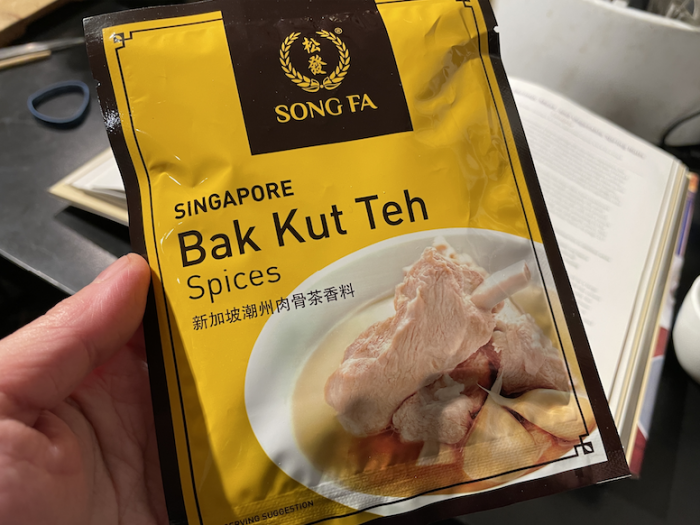
Song Fa sells spice packets for making bak kut teh at home both in their stores and on the website (I’ve also seen it on Amazon) and in Singaporean grocery stores. I’ve made bak kuh teh a few times since our 2022 trip and I think it comes out best with a combination of the Song Fa packet and additional fresh spices. The main thing you can’t believe until you do it is just how much white pepper it takes to really get the flavor right. (Also 5 heads of garlic per rack of ribs.)
I used the following reference recipe, as well as the instructions on the Song Fa packet, and a few others I looked up: https://delightfulplate.com/bak-kut-teh-singapore-pork-rib-soup/
But here’s what I ended up with:
My BAK KUH TEH recipe
- 1 rack of pork ribs (12-13 ribs)
- 25 fresh peeled garlic cloves (or 5 heads of however many cloves)
- one Song Fa spice package
- several slices of fresh ginger
- one cinnamon stick
- two tablespoons white peppercorns
- 2 star anise
- 1 tsp dark soy sauce
- 1 tsp light soy sauce
If you don’t have the Song Fa packet, you can replace it with 30 grams of white pepper (yes that is most of a grocery store container of white peppercorns) whether as whole peppercorns or ground, 10 grams of sea salt, 5 grams of cinnamon chunks or sticks, and 4 broken star anise. (And MSG if you want it. I find this meal has enough umami and salt without it.)
Buy a long flat rack of pork ribs when it’s not grilling season and you can find them on sale for $5.99 a pound (they’ll jump to $12.99 a pound or more in barbecue season). In fact, buy a few and freeze them until you’re ready to use them for bak kuh teh.
First bring a LARGE pot of water to a boil (large enough for all the ribs.) Cut up the ribs and peel 50 cloves of garlic while you’re waiting for the pot to boil. Put a few pinches of salt and some slices of ginger in the water. Once it gets to a rolling boil, put all the ribs in and return it to a boil. Parboil one minute, then discard the water and rinse the ribs well with cold water.
Clean out the pot. Some recipes now have you toast the spices and garlic cloves in the bottom of the pot before you refill it with water, but I have not done that. Add fresh water, and the ribs, and bring it to a boil again. Then add all the garlic cloves, and both soy sauces. Have the spices in either tea balls or other infusers, or those disposable tea bags, and halfway through the cooking, be sure to move them around a bit (but don’t break them or the soup will be gritty).
Simmer 90 minutes to 2 hours. Serve with 3 ribs per large soup bowl and a ladle or two of the broth. In the Song Fa restaurant, they strain the garlic cloves out to make the broth clear again, but I leave them in. (They’re mostly disintegrated.)
If you’ve ever wondered why “vegetarian delight,” the really bland vegetable dish served at Cantonese restaurants, exists at all, it’s because it’s the perfect balance to offset the intensity of bak kuh teh.
Of course, because this is DUCK DAY, we cooked up a version that used duck legs with some meat still on them as a stand-in for the ribs, and duck stock, and the rest was the same spice mix and garlic, and it came out fantastic. (There are many non-pork variations including duck to be found around Malaysia, Indonesia, etc. but I didn’t really look up any recipes, I just swapped in duck for pork and it worked.)
Somehow I didn’t get a photo of the duck kuh teh, but here’s one from Regis’s instagram (full post here: https://www.instagram.com/p/C0CC9Z2L0oM/):

The other traditional accompaniment is a long, bumpy “cruller” — you tiao. The first time I made the crullers, I used a gluten free recipe because I was making this meal for a friend who with a few dietary restrictions and they came out surprisingly great! So I thought surely with actual gluten in them they should be even better? (I actually think they came out about the same.) The gluten free version came from Fun Without Gluten (https://funwithoutgluten.com/chicken-congee-with-gluten-free-chinese-doughnuts/) and the regular version came from What To Cook Today (https://whattocooktoday.com/cakwe-you-tiau.html).
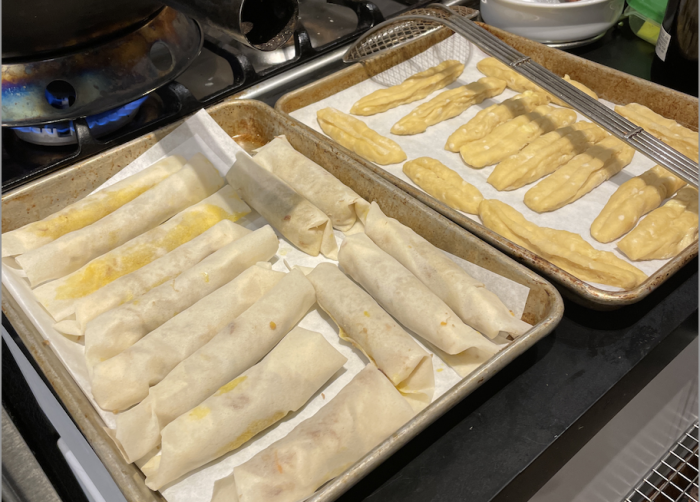
DUCK-CONFIT FILLED CRISPY LUMPIA
So, lun pia, or lumpia if you’re filipino, are another southern Chinese specialty that are all over the Philippines. They require super-thin, almost lacey skins, and I’ve made them by hand before. The recipe I use comes from the indispensible cookbook that is Andrea Nguyen’s ASIAN DUMPLINGS. You can read a review of her recipe on the aptly named Burnt Lumpia blog: https://burntlumpia.typepad.com/burnt_lumpia/2009/09/homemade-lumpia-wrappers.html
However, this time, in the middle of the heat of service of an already too-long meal… I could not get the dough to work. The pan was too hot, then it was too cold, then the dough was too wet, or maybe too dry? I don’t know why it didn’t work, and I didn’t have time to figure it out, so I defaulted to the back-up plan: the “shanghai style” extra-thin spring roll skins I had bought at H-Mart a few days earlier, for just such a contingency.
The filling was shredded duck confit, which stands in very well for the finely shredded pork one often finds in these at parties catered by filipino caterers. (I just gave myself such a craving for lechon, holy cats.)
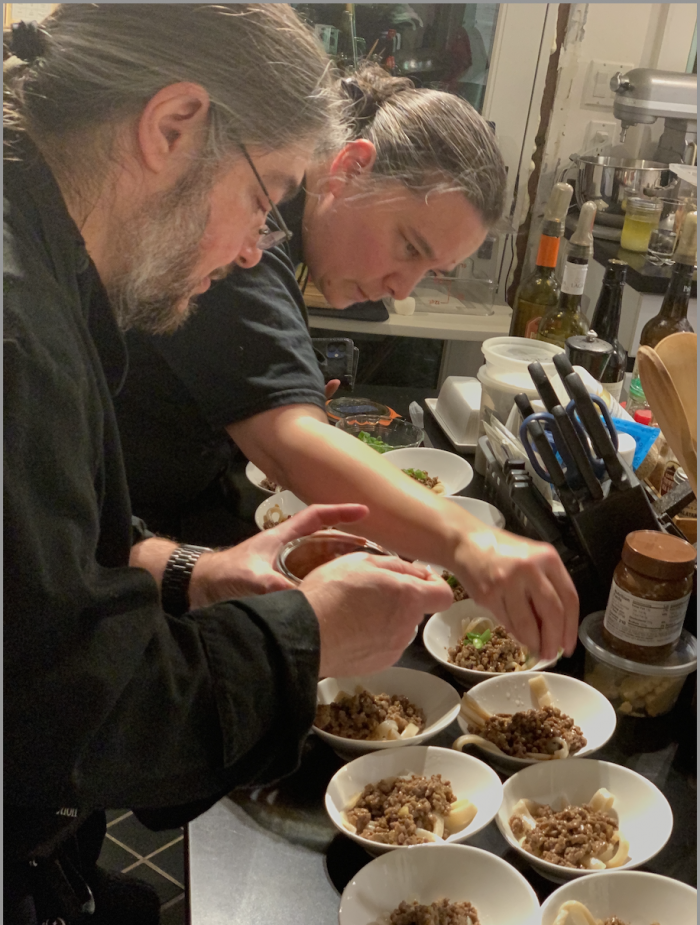
Hand-cut Sweetwater noodle w/ ground duck topping
corwin learned to make these thick, chewy, rustic noodles from, where else, Chinese Cooking Demystified. Here: https://chinesecookingdemystified.substack.com/p/chengdu-sweet-water-noodles
But I’m the one who ended up actually doing the hand-cutting of the noodles, and I fixed up these accordion dividers out of wax paper to keep them from sticking together.
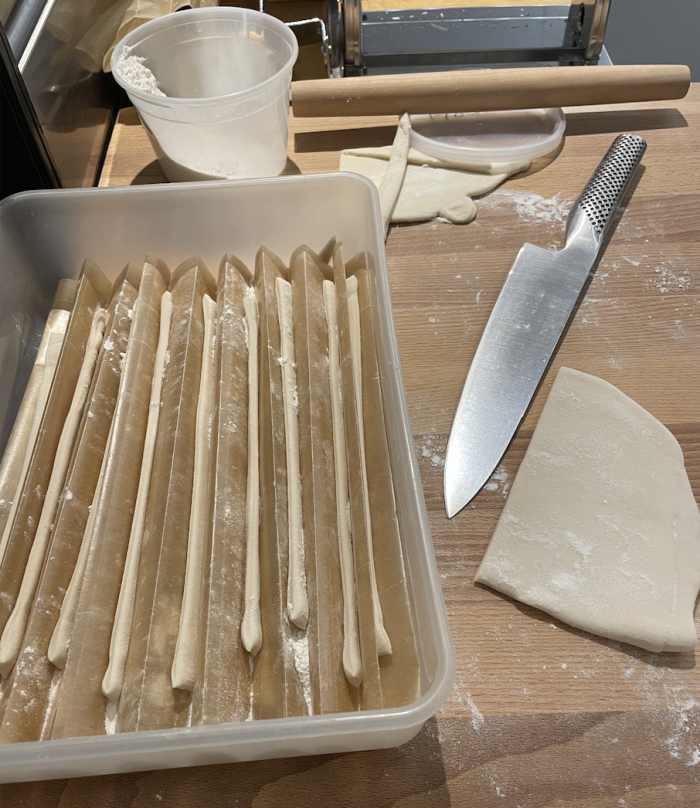
Trio of sorbettos: ginger, lychee, orange
We made these three sorbets that came out in three different textures as well as three flavors. The ginger was so intensely gingery and so intensely sugary (because corwin used the sugar that was left in the pot after I candied ginger to make it) that it wouldn’t actually freeze. It remained creamy in texture and had to be kept in the deep freezer, not the upright, or it turned to soup. And he used the sugar leftover from me candying the buddha’s hand to make the orange sorbet. And we used canned lychee for the lychee sorbet, but I don’t remember the details now…
The main thing is we have a decent ice cream maker (Whynter brand) that can be left unsupervised while it aerates and freezes.
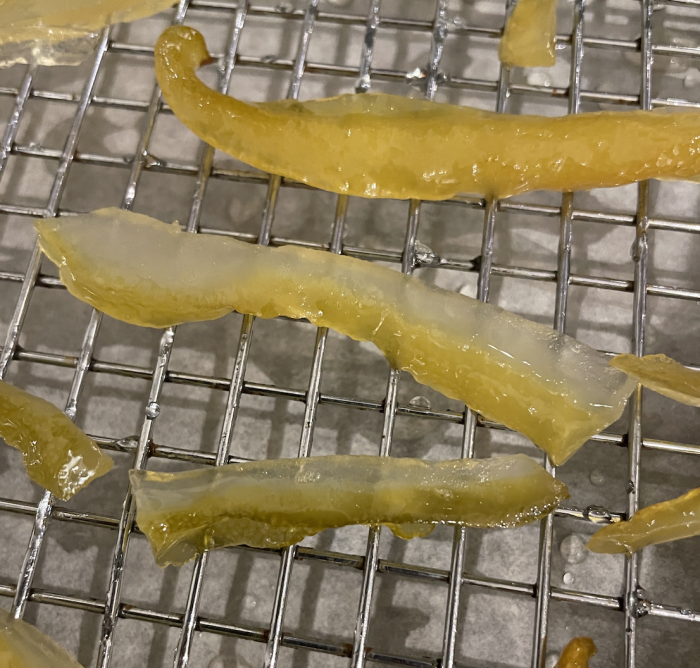
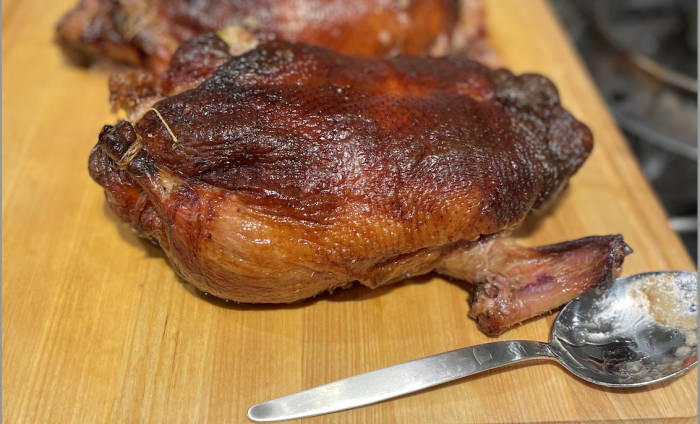
Sticky-rice stuffed roast duck (main dish)
With Scallion & Cucumber garnish
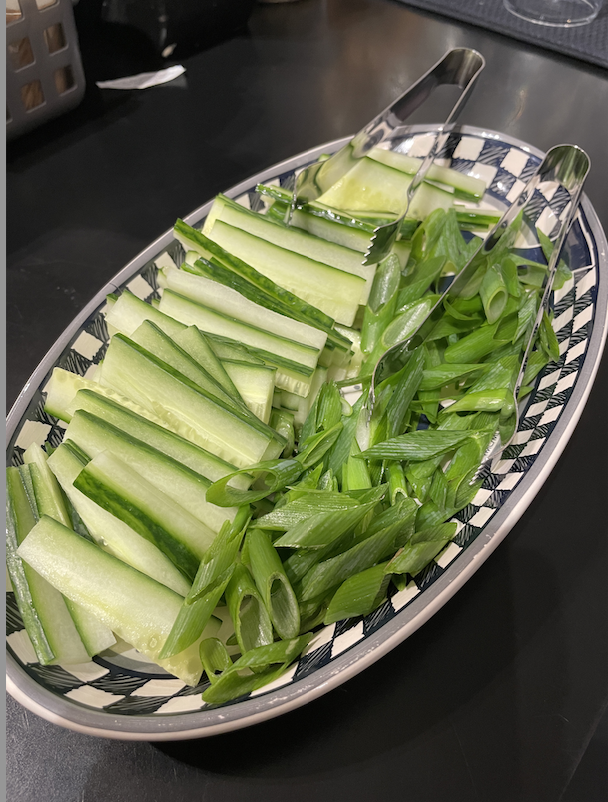
This is a variation on a duck we’ve done before, the first time probably around 1994 or 1995,? The recipe comes from the cookbook entitled WORKING A DUCK by Melicia Phillips. (Used copies are on sale on Amazon) The variation is that we now use the Kenji Lopez-Alt recipe for getting the peking-duck style skin on the exterior (at Serious Eats; https://www.seriouseats.com/peking-duck-mandarin-pancakes-plum-sauce-recipe), which is to use maltose syrup on the exterior. You debone the interior of the duck and then stuff the large remaining cavity with sticky rice stuffing, which is just delicious no matter what.
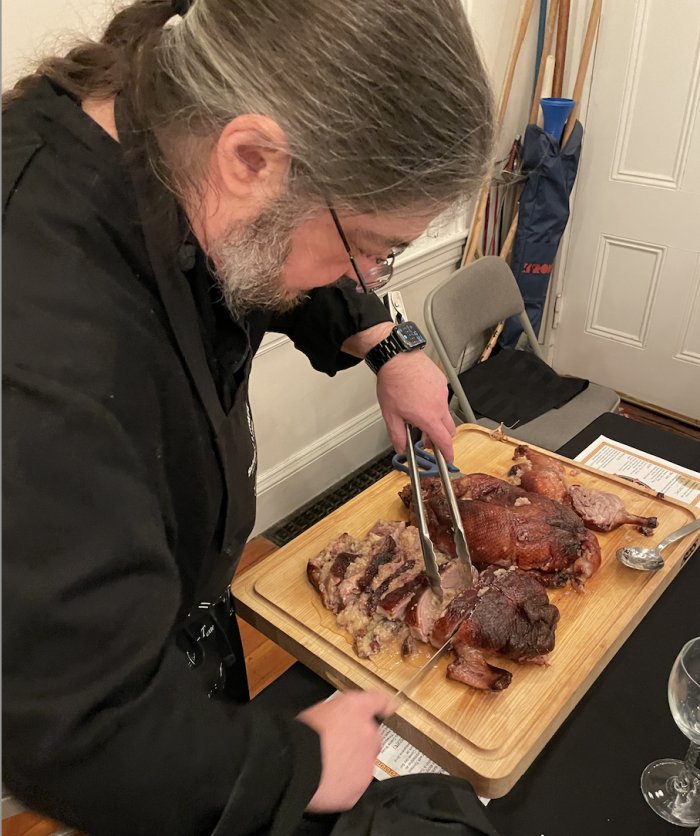
Yuzu Creme Brulee
I just followed the usual creme brulee recipe from Joy of Cooking that we love, the one with only egg yolks and no whites in it, and added about a 3/8ths of a cup (6 TBS) of Yuzu juice and some yuzu zest, inspired by this recipe here: https://www.essentialingredient.com.au/blogs/essential-recipes/recipe-yuzu-creme-brulee
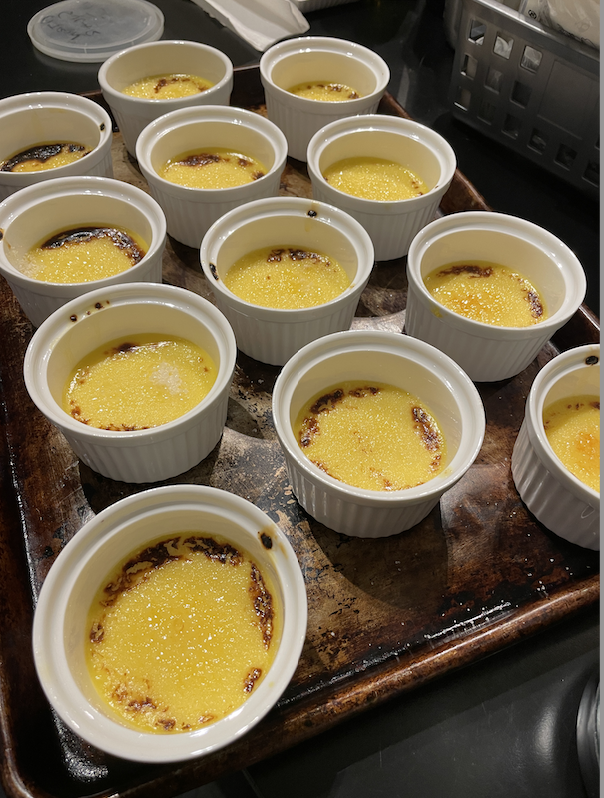
Pineapple Bun
Another dim sum classic that I’ve been craving. Clearly the only solution was to make our own. Because this was already a very long and heavy meal, I thought I would make these smaller than usual. But I forgot. I followed this receipt at Woks of Life: https://thewoksoflife.com/pineapple-buns/
(For Chinese New Year this year, though, I’ll be trying to make a custard-filled version)
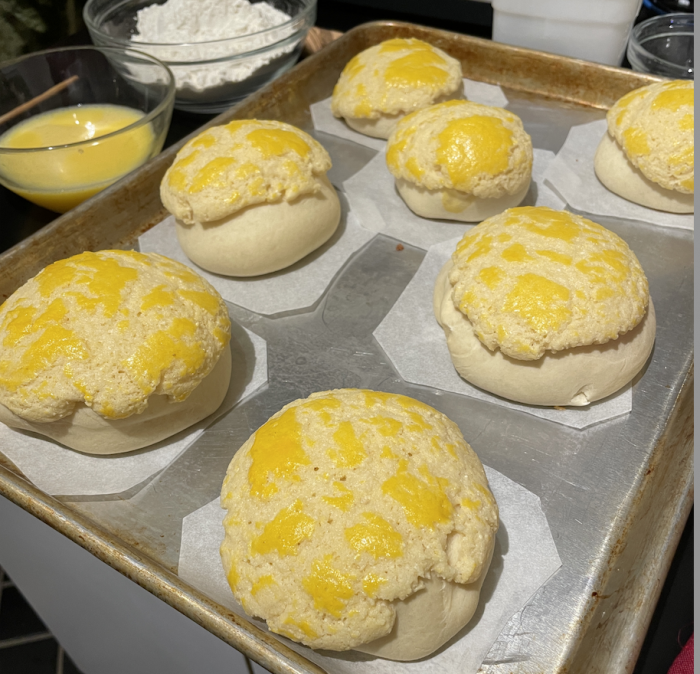
Appendix: The Fortunes
Yeah, I wrote these. I do have a box that I’ve been saving fortunes for cookies in for over 40 years, but I wrote these from scratch, which seemed more fun than recycling:
- Your next big accomplishment will be like a stray cat, either, arriving unexpectedly and bringing much joy, or covered in fleas
- An acquaintanceship will blossom into a friendship, if you put some sunlight and water and don’t mind the thorns
- Stop denying yourself that which you really want (unless what you want is a pan flute)
- Don’t forget that sometimes to hear the music, you have to put your earplugs in
- While it is true that oil and water don’t mix, it is also untrue if you believe in emulsification
- “The sky is the limit” is supposed to mean your success is limitless. But pedants would disagree.
- Your life will soon run like a well-oiled machine, needing constant upkeep from fosssil fuels.
- The woods are lovely, dark, and deep, I hope your tea won’t oversteep
- To weather future trouble, heed this timeless advice: “Take your protein pills and put your helmet on.”
- Sometimes if you’re a big fish in a small pond, the best thing to do is grow legs and walk to the beach
- An unexpected offer will be coming your way. Accept it (unless it’s from an online ad of course)
- Today’s outlook: either Martians will attack or you are not starting a new diet today.
- When you look into the eyes of someone you love, they should be like tidepools, teeming with mystery. And maybe starfish.
- Bruce Lee said “Be water” but he didn’t specify sparkling or still. That part’s up to you.
